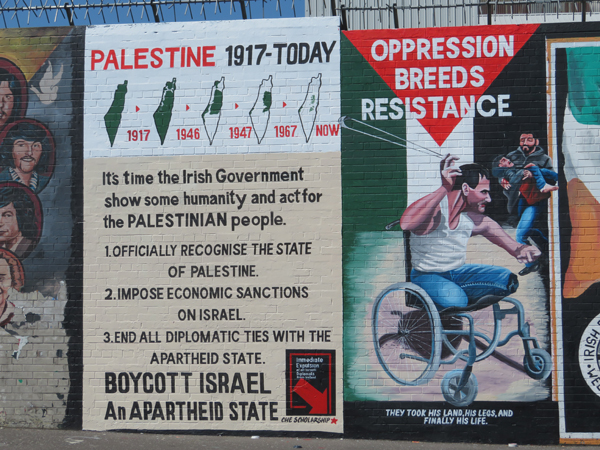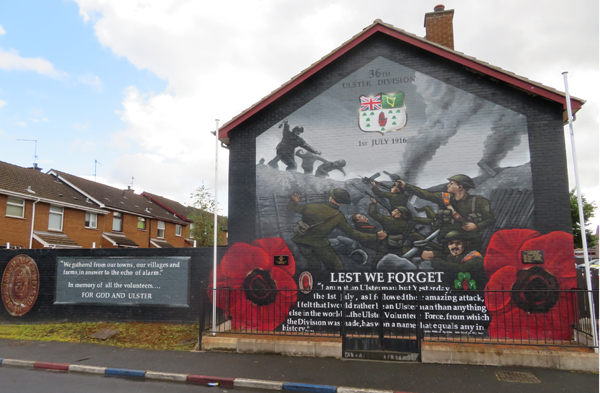‘War comics without the humour’ v. ‘Sistine Chapel-lite’?
Published in Issue 5 (September/October 2019), Platform, Volume 27Loyalist and republican murals compared.
By Bill Rolston
In June 2019 there was a brief flurry of controversy regarding the political wall murals of Northern Ireland. It was started when a BBC reporter, Chris Lindsay, read an article about them in an inflight magazine on Singapore Airlines. He traced the source back to Fodor’s Essential Ireland. The BBC then raised a number of questions about the article’s tone and accuracy. As a result, Fodor withdrew the account from its online site and promised to remove it also from a reprint of its print edition.
The core of the offending account was that there was a stark difference between the two sets of murals. Loyalist murals were said to ‘resemble war comics without the humour’, while republican murals ‘often aspire to the heights of Sistine Chapel-lite’. Had that been the extent of the criticism, it might have passed relatively unnoticed. Whether with a tongue-in-cheek attitude or not, however, the author elaborated on loyalist murals:
‘… typical subjects include wall-eyed paramilitaries perpetually standing firm against increasing liberalism, nationalism and all the other -isms Protestants see eroding their stern, bible-driven way of life’.
Thus the author succeeded in turning a relatively unremarkable point into what comes across as a prejudiced account.
Superficially, republican and loyalist murals seem to be identical phenomena. They make statements of political propaganda through paint for their respective constituencies. (That said, there is an increasing trend, more marked on the loyalist side, of producing ‘digital murals’, designed on computer and printed on large sheets of Perspex to be attached to walls.) But because they represent different, and antagonistic, political world-views, that is often as far as the similarity goes. Let’s take two examples. The first unionist mural was painted in Belfast in 1908 and depicted King Billy at the Battle of the Boyne. For the next 70 years the bulk of unionist murals were on that theme. In the mid-1980s there was a sudden transformation. Loyalist paramilitary commanders in effect took over control of the walls in their areas, thereby transforming what was a unionist tradition into a narrower loyalist one. The message was sectional, and the iconography was more or less reduced to images of masked and armed members of their respective organisations, the UVF and UDA, to promulgate the message that they, and only they, could properly defend Ulster from republican rebellion.
During the 1980s and 1990s republican muralists also painted masked and armed men—and sometimes armed women—but that theme did not monopolise the output. While the IRA had particular walls where its message of insurgency was displayed, it did not seek to dominate the scene. Moreover, republicanism is a fairly broad church, and so republican socialists, feminists, trade unionists, environmentalists and internationalists could all find spaces on local walls for propaganda. While the conflict raged, the difference between the two sets of murals was obvious. A quarter of a century later it is still apparent; loyalists continue to paint masked and armed men. These images, however, do not monopolise the walls as they did previously; loyalists sometimes paint on other themes. Among these are depictions of Irish regiments in British wars, and in particular the 36th Ulster Division at the Battle of the Somme. It is progress of a sort; legally armed men have replaced illegally armed men, but the emphasis is still on arms.
By comparison, republican muralists decided in 1998 to cease painting contemporary armed men. The few guns in republican murals are in memorial murals to dead comrades or historical murals; in both cases the guns are not contemporary. The second stark difference relates to the world beyond Northern Ireland. Republicans find a resonance in the struggles of other peoples internationally against colonialism and repression. That identification is particularly heartfelt in relation to liberation struggles whose members end up dead or in prison. So there are murals about prisoners and activists in Palestine, Sri Lanka, Cuba, the Basque Country, Kurdistan and South Africa, and, beyond that, references to struggles in places as diverse as Catalonia, Mexico and Yemen.
Although there have been on some occasions direct connections, political or military, between republicans and these other activists, the point is a wider and deeper one: ‘We are like them, they have suffered and struggled as we have’. It is easy to criticise this message as unsophisticated and ignorant of the complex differences between different struggles, but from the republican movement’s point of view the solidarity expressed works both ways, not simply as a message to these other places but also from these other places, a message that says ‘We are not alone’.
This is a message that is difficult for loyalist muralists to express because, compared to republicanism, theirs is a much narrower political ideology. In terms of international resonance, therefore, loyalism can feel like a very lonely place. With the exception of Israel, there are few international references in loyalist murals, and even then there is a suspicion at times that support for Israel is more about annoying republicans, who support Palestine, than anything else. For loyalism there is a real sense of existential angst, which is not conducive to expansive messages of any kind. This angst is not easily cured by reassurances that, as a result of the Good Friday Agreement, Ulster is safe. There is a strong conviction among many loyalists—not, incidentally, always empirically provable—that republicanism has gained much more from the peace process. There can even be times when loyalism can fear that the connection to Britain is not as assured as it was once believed to be. ‘Sinn féin’ is sometimes mistranslated as ‘ourselves alone’ rather than simply an emphatic ‘ourselves’, yet paradoxically, as far as the walls are concerned, it is a mistranslation which seems to fit contemporary loyalism better than republicanism.

Above: A republican pro-Palestinian mural on Divis Street, Belfast. Republicans find a resonance in the struggles of other peoples internationally against colonialism and repression.
In the abstract, there is one possible pathway out of this impasse—namely, to return the walls to the whole unionist community rather than the militant section of it. Murals could then explore the aspirations and fears of the whole community—from youth unemployment to women’s rights, from Brexit to what liberal unionism might mean, and, indeed, whether there might be an antidote to existential angst. While the loyalist paramilitary commanders retain control of the walls this is unlikely to happen.
There is, of course, another possible solution: to obliterate the murals altogether. There are problems with this suggestion, not least that, although the State could send people to wipe out the murals, the consequence could well be that every deleted mural is replaced by a number of new murals. This is why the State’s preference has been to negotiate the replacement of murals through a scheme known as the Reimaging Communities Programme. Beyond this, the call for obliteration misses the point that the murals are a consequence of deeper political issues in society relating to justice, equality and legacy. Change those underlying issues and the murals would change. Moreover, there is something positive to be said for mural painting, even if it periodically throws up offensive images. The murals are a form of political articulation, with their roots in working-class communities. These are the communities that are often marginalised and left behind in democratic society. At least in Northern Ireland what some in these communities think is plain to see. In this scenario the goal should be to allow all sections of the communities to have their say in this democratic exercise. Keeping the murals while transforming their most offensive aspects might save the baby while throwing out the proverbial bath-water.
Bill Rolston is Emeritus Professor of Sociology at the University of Ulster.

Top: A loyalist mural in Montague Street, Portadown, commemorating the 36th Ulster Division. In recent years depictions of legally armed men have replaced illegally armed men—progress of a sort.
















